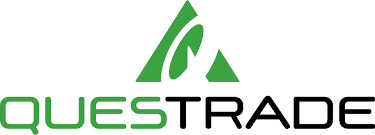Questrade vs Wealthsimple – Which is Better in 2026?
Many Canadian DIY investors end up comparing Wealthsimple vs Questrade as they’re two of the biggest names in the game. Both brokerages built their reputations by hammering home the same message (largely through savvy Youtube campaigns): Canadians pay way too much at the big banks. Toss in free trades, easy-to-use platforms, and a race to zero-commission trading, and it’s easy to see why they’ve attracted millions of accounts.
But here’s the part most comparison articles skip over: Even though Wealthsimple and Questrade are household names, neither one is my top pick. That spot still belongs to Qtrade, thanks to its combination of reliability, account flexibility, long-term planning tools, and (*NEW*) commission-free trades.
If you’re shopping around to make sure you get the most bang for your buck, then take a look at their latest promo as it’s one of the best I’ve seen in years. You can get the full breakdown in my Qtrade Review.
Before we dig into Wealthsimple vs Questrade, it’s important to understand that these two platforms take fundamentally different approaches to investing. This isn’t an apples-to-apples matchup. Knowing what each platform is designed to do will save you a lot of frustration and help you figure out which one actually fits the way you invest.

Best 2026 Broker Promo
Up To $2,000 Cash Back + Unlimited Free Trades
Open an account with Qtrade and get the best broker promo in Canada: 5% cash back when you fund a new account!
The offer is time limited - get it by clicking below.
Must deposit/transfer at least $1,000 in assets within 60 days. Applies to new clients who open a new Qtrade account by January 5, 2026. Qtrade promo 2025: CLICK FOR MORE DETAILS.
Questrade Vs Wealthsimple: Quick Comparison
Check out the table below for a side-by-side comparison of who each platform is best for to customer service and other key features.
| Discount BrokeR | Robo-Advisor | |
|---|---|---|
 | ||
| Best For | DIY Investing | Passive Investing |
| Fees |
|
|
| Style | Hands on. You're in the driver's seat. | Hands off. You decide on a strategy (with the help of an automated survey and an advisor). |
| Customer Service | No one to ask for help. You are effectively on your own. |
|
| User Friendliness | As complicated as you want to make it. One-off index buy or a daily rebalance/trading - up to you. | The easiest way to turn a part of your paycheque into an excellent investment portfolio. |
| RRSP + TFSA + RESP | Yes | Yes |
| Full Review | Questrade Review | Wealthsimple Review |
| promotion | $50 in Free Trades | $50 Cash Bonus |
| Sign Up | Visit Questrade | Visit Wealthsimple |
For additional comparison options, I recommend checking out our Qtrade vs Wealthsimple article, as well as our Qtrade vs Questrade comparison.
The Key Difference: Managed Investing vs. DIY Trading
Wealthsimple offers a hands-off investing experience through Wealthsimple Invest, which is a robo advisor. This is perfect for folks who want to “set it and forget it.” You deposit your money, and the platform automatically invests it in a diversified mix of ETFs. It’s all based on your risk tolerance and financial goals. Wealthsimple handles everything from asset allocation to rebalancing – all for a small management fee.
Questrade, on the other hand, is a DIY online brokerage. It’s for people who want more control over their investments. If you’re comfortable doing your own research, picking your own stocks, or building your own ETF portfolio, Questrade gives you all the tools you need. You get to make your own trades, choose your own strategy, and have full control over your investment decisions.
Questrade vs Wealthsimple Summary
You can read below to see the detailed breakdown of the two robo advisors: Questwealth Portfolios vs Wealthsimple Invest, as well as the head-to-head comparison of the online brokers: Wealthsimple Trade vs Questrade Brokerage.
DIY Online Brokerages: Low-cost platforms where you can buy and sell stocks, ETFs, and other individual investments. These tools are ideal for hands-on investors who prefer to manage their own portfolios and don’t mind doing a little reading to get started.
Robo Advisors: Each company also offers a robo-advisor platform. Sometimes referred to as automated wealth managers, these platforms are designed for investors looking for a hands-off approach. While robo-advisors charge slightly higher fees than DIY brokerages, they also provide advice and automated solutions.
If you’re unsure which approach suits you best, it’s worth learning more about the Best Canadian Robo Advisors to see if they align with your financial goals.
If you just want the short and sweet version though, here’s the MDJ editorial 3-minute decision tree.
1) If you want the easiest and quickest way to invest – along with some solid financial advice and help using the platform – then go with Wealthsimple Invest, Wealthsimple’s Robo advisor.
You’ll get instant diversification into index funds, and it will be the easiest app you’ll ever use. Questwealth Portfolios is fine – but it leaves something to be desired on both the user experience and investing style.
Quick Note: If you’re looking to trade cryptocurrencies (not our thing) then Wealthsimple Crypto is the Canadian leader in this category. It is included as part of the Wealthsimple Trade platform.
2) If you’re looking to pick stocks and cut costs to the bone, then check out our constantly-updated comparison of the best online brokers in Canada.
Both Questrade and Wealthsimple Trade are mentioned. We at MDJ have found Wealthsimple Trade to be really “buggy” compared to their smooth and efficient robo advisor. Personally, we think either Questrade or Qtrade is the best fit for most of Canada’s investors.
Why the Comparison Gets Tricky
Comparing Wealthsimple vs. Questrade can be like comparing apples to oranges because you’re really looking at two different types of investing. If you’re a hands-off investor who just wants a low-cost, automated way to grow your money, then Wealthsimple Invest is the better choice. But if you want to pick and choose your own investments – and you’re willing to put in the research – then Questrade is the way to go.
If you’re looking for a robo advisor experience with more customization and a dedicated financial advisor, Justwealth is worth a look. It’s currently my top pick for robo advisors in Canada.
And if you’re leaning towards a DIY online brokerage but want the best combination of low fees, research tools, and customer support, Qtrade is still my #1 choice. It just does everything a little bit better than Questrade – and it has a fantastic promo going on right now.
Bottom line? Make sure you understand the type of investor you are before making a decision. Wealthsimple and Questrade are both solid platforms, but they cater to very different investing styles. If you’re not sure which one suits you best, it might be worth reading my more detailed breakdowns on each platform or even giving both a test run. Just remember: the best platform is the one that matches your investing style, comfort level, and financial goals.
Discount Brokerages vs Robo Advisors
To make the best choice in the Wealthsimple vs Questrade battle for investment dollars, it’s important to understand the differences between the different types of platforms that allow Canadians to invest their money.
Robo Advisors: NOT ROBOTS – but a way to automate your way to a healthy nest egg! The basic idea is that robo advisor platforms make it as easy possible to take a piece of your paycheque and turn it into an addition to your TFSA, RRSP, or non-registered account.
The added benefit is that you will still have access to a real human if you need to ask questions or are in need of general advice.
Wealthsimple is currently ranked #1 in our list of best Canadian robo advisors.
DIY Online Brokerages: If you want to cut costs to the absolute bone and are willing to do a bit of reading and math, then an online brokerage will be the right platform for you. Keep in mind that you’ll be in charge of executing all transactions, so you’ll need to be comfortable with that. Also note that with these platforms, there is no advice component available.
It’s key to understand that Questrade started as a DIY online broker and added a robo advisor, while Wealthsimple started as a robo advisor and has added a DIY online broker.
So your decision ultimately becomes not just Wealthsimple vs Questrade, but really Wealthsimple Trade vs Questrade Brokerage, and Wealthsimple Invest vs Questwealth Portfolios.
Questwealth Portfolios vs Wealthsimple Invest
The way that Questwealth Portfolios invests your money vs how Wealthsimple Invest puts your money to work, is the single biggest difference between these two automated investing services.
- Questwealth Portfolios = Active Investing
- Wealthsimple Invest = Passive Investing
What this active vs passive argument boils down to is that when a company actively invests your money, it means that they are trying to pick and choose which investments will create the highest investment returns. A passive investing strategy is when an investor or company simply seeks to own a small piece of every company or bond in a given market. In the case of a Wealthsimple portfolio, this means owning small pieces of thousands of companies from all around the world, as well as hundreds of bonds.
The investments in your Questwealth Portfolio are actively managed by a company named One Capital Management, based in Los Angeles, California.
Getting “experts” to pick the best investments to put in a portfolio might sound good in theory. The problem is that most of the time “experts” are really bad at actually selecting the best investments for their clients. There are many reasons for this fact, but what it comes down to is that it’s really, really hard to get an edge on everyone else in the stock or bond market. This shouldn’t be a surprise considering who is involved in trying to outdo each other in these markets.
Remember that for every share or bond you sell, there is someone on the other end who thinks they got the better deal.
These companies compete against each other every day using brilliant brains from Ivy League schools, supercomputers that should probably be used at NASA, insider information gleaned from their paid “consultants” who are former politicians or staffers, etc. As soon as one of these money managers or companies gain an edge, it is often quickly copied by the others. Consequently, to be “above average” at picking the best investments is quite difficult, and the people who can do it usually run relatively small hedge funds for the world’s wealthy – not investments aimed at the average retail investor.
Study after study has shown that passive investment’s strategy of “owning the entire market” and guaranteeing yourself the average overall return is far and away a better strategy than hiring someone to “beat the market” for you!
If you want more insights on why passive investing has fared much better than active investing, please read these articles (or just trust that I read them).
1) Here’s why Warren Buffett (one of the world’s best stock pickers) says that you should passively invest your money.
2) Here’s an example of Buffett actually winning a $1 Million bet that an index fund would beat an elite hedge fund.
3) Here’s another example of how active management has lost for the last 9+ years.
Both Questwealth Portfolios and Wealthsimple Invest also include Socially Responsible Investing (SRI) options, but only Wealthismple has Halal Investing options for Islamic investors.
Additionally, in 2020 Wealthsimple launched their own socially responsible investing funds rather than relying on third party responsible investing ETFs which they have been doing since 2016.
January 2026 Update: While I will always admire Wealthsimple for really pushing index investing forward in Canada, their actions over the last few years have really soured me on the company. As more and more of the company has been purchased by one of Canada’s largest firms, the quest for profits has massively taken over the mission of helping everyday Canadians.
There has been far pushing of high-profit trading activities like cryptocurrency. They don’t even call their robo advisor platform “Wealthsimple Invest” anymore (which was a great title), now it’s “Wealthsimple Managed Investing”.
The final straw for me was when they repeatedly changed the make-up of their passively invested portfolios over the last few years (which is by definition NOT passive) and made pretty bad bets each time. Ben Felix and Rob Carrick have both written at length about these poor investment choices in the Globe and Mail.
For more information on my choice for top robo advisor in 2026, I recommend checking out my Justwealth Review.
Winner: Wealthsimple Invest… for now.
Questwealth Fees vs Wealthsimple Fees
If you want to see what a robo advisor is all about, or are just getting started with investing, then Wealthsimple has a fantastic promotional offer which includes getting a $50 bonus on a $500 or more deposit.
Questwealth Portfolio has no such introductory offer at this time. However, there is no denying the long-term edge that Questwealth Portfolios have when it comes to a pure comparison of MER. For smaller portfolios (less than $100,000) Questwealth Portfolios charge .25% MER + the cost of the underlying ETFs. Wealthsimple Invest charges .50% MER + the cost of underlying ETFs. For larger portfolios, the costs come down to .20% MER vs .40% MER respectively.
That said, I remain very skeptical that this relatively small difference in fees (.2% MER comes out to about $16 per month on a $100,000 portfolio) is enough to justify the shortcomings of active management.
Winner: Smaller Portfolios = Wealthsimple, Larger Portfolios = Questwealth
Robo Advisor Features
While I’m not a big fan of Wealthsimple’s brokerage platform, there is no denying that the bundle of features they have put together to go with the Wealthsimple Invest robo advisor service is excellent (and has continually grown).
Because Power Corporation has invested so much money into Wealthsimple, it shouldn’t come as a surprise that it has been able to really lead when it comes to fintech (“financial technology”) innovation.
Both Wealthsimple Invest and Questrade Portfolios will allow Canadian investors to open and use the most common Canadian accounts such as the RRSP, TFSA, RESP, FHSA, Non-registered, and corporate accounts. Both platforms offer limited help and advising services. Ultimately, both of these robo advisors are great at providing a super quick and easy way to build a diversified investment portfolio.
But Wealthsimple really shines when it comes to the following “extras” that they’re able to provide for Wealthsimple Invest customers.
1) When you invest $500,000 with Wealthsimple Invest, you hit their top tier – called “generation” – and get little perks like a personalized financial plan and three out of 10 of their Milestone Rewards which include UberOne, DINR and Globe and Mail subscriptions.
2) All investors can make use of Wealthsimple Tax that allows clients to quickly and easily file their own tax returns for FREE each year. It’s sort of like an in-house Turbo Tax.
3) 3) Access to Wealthsimple Chequing, which is a High Interest Chequing Account option. Canadians could open up an EQ Bank Account outside of their Questwealth Portfolios account and get access to a better online banking option than Wealthsimple Chequing – but some folks just like have everything “under one financial roof.”
4) The other ground-breaking area that Wealthsimple has staked out within the Canadian market is Wealthsimple Crypto. Now, I personally think crypto trading is a quick way to make your money disappear, and several of the cryptocurrencies that Wealthsimple Crypto used to trade have basically gone up in smoke. That said, if you want to gamble in these markets, Wealthsimple will let you trade more than 60 types of cryptocurrencies including:
0x (ZRX), Aave (AAVE), ApeCoin (APE), Amp (AMP), Ankr (ANKR), Avalanche (AVAX), Axie Infinity (AXS), Balancer (BAL), Band (BAND), Basic Attention Token (BAT), Bitcoin (BTC), Bitcoin Cash (BCH), Cardano (ADA), Chainlink (LINK), Compound (COMP), Curve (CRV), Decentraland (MANA), Dogecoin (DOGE), Ethereum (ETH), Fantom (FTM), Filecoin (FIL), Kyber Network (KNC), Litecoin (LTC), Maker (MKR), Ox (ZRX), Polkadot (DOT), Polygon (MATIC), Ren (REN), Steller (XLM), SushiSwap (SUSHI), Synthetix (SNX), Uma (UMA), Uniswap (UNI), Yearn.Finance (YFI) and 1inch (1INCH).
Questwealth Portfolios doesn’t offer these types of perks and cross-selling of products that Wealthsimple has put together. Their value proposition is simply that they have the lowest fees in the Canadian robo advisor world.
It’s also worth mentioning that Wealthsimple is another level when it comes to design. Ever since their founding a decade ago, the company has really prioritized flawless user experience, and making things as easy as possible for customers. Their design team has won several awards, and there is no question that everyone else in Canada’s fintech universe has been playing catch up when it comes to looking pretty on both a mobile app and on a desktop.
Personally, a pretty app isn’t my first prioritize when I pick a platform to manage my money, but I’m always surprised at how positively folks react to superior design. If it motivates you to stay consistent with your investing, there is certainly a good argument for it!
Clear Winner: Wealthsimple
Quick Compare: Wealthsimple Invest vs Questrade Robo Advisor (Questwealth)
| Feature | Wealthsimple Invest | Questwealth Portfolios |
| Management Fees | 0.5% (below $100k), 0.4% (above $100k) | 0.25% (below $100k), 0.20% (above $100k) |
| Investment Strategy | Passive | Active |
| Minimum Deposit | $0 | $1,000 |
| ETFs MER | 0.12% to 0.15% | 0.10% to 0.14% (ETFs), 0.21% to 0.35% (SRI) |
| Rough Total Annual Fees on a $100,000 Portfolio | $650 | $400 |
| Rough Total Annual Fees on a $500,000 Portfolio | $3,250 | $1,800 |
| Account Types | RRSP, RRIF, LIRA, RESP, TFSA, FHSA, Personal, Joint, Business | RESP, RRSP, RRIF, LIRA, LIF, TFSA, FHSA, Cash, Corporate Cash |
| Currency Exchange Fee | 0-1.5% | 1% |
| Tax-Loss Harvesting | Yes | Yes |
| SIPF Protection | Yes | Yes |
| Investment Products | Stocks, ETFs, Options, Margin, and Bonds | Stocks, Options, ETFs, Bonds, IPOs, GICs, Precious Metals, Mutual Funds |
| Trading Fees | Free | $4.95 to $9.95 for stocks, $9.95 + $1/contract for options |
| Socially Responsible Investing (SRI) | Yes | Yes |
| Promotions/Offers | $25 bonus (with $500 deposit), $150 account transfer fee reimbursement | Referral rewards ($25 per referral, $50 every third referral) |
Conclusion: Wealthsimple is Canada’s Top Robo Advisor
Despite giving up a couple of MER points in fees, the combination of unsurpassed features, superior passive investing strategy, and award-winning user experience, leave Wealthsimple standing alone atop the mountain in the Questrade Portfolios vs Wealthsimple Invest robo advisor battle.
Conclusion: Neither Wealthsimple nor Questrade is Canada’s Best Robo Advisor Option
Even though Wealthsimple charges slightly higher MERs than some competitors, their overall platform is still tough to beat. Their interface is excellent, the automation is smooth, and their passive investing approach remains one of the most user-friendly options in Canada. When you stack it up against Questrade Portfolios, Wealthsimple still comes out ahead in the robo advisor matchup.
That said, Wealthsimple hasn’t been at its best the last few years. Some of their product pivots and upselling experiments have annoyed long-time users (myself included). If they’d simply stick to what they used to do so well ( clean, boring, low-cost index investing) the platform would get much higher marks from me.
Between the two robo options, Wealthsimple gets the edge… BUT – both Wealthsimple and Questrade are still well behind Justwealth.
Justwealth doesn’t have the flashy ads or the big-brand recognition, but they quietly offer the strongest advice, the smartest portfolio construction, and excellent investment performance. Add in their current $100 – $500 cash-back promotion, and it’s easily the best value in the Canadian robo advisor space right now.

Best 2026 Canadian Robo Advisor Promo:
Up To $500 in Cash
Open an account with Justwealth and get the best robo advisor promo offer in Canada*.
Justwealth has the best portfolio performance out of all Canadian robo advisors + the best promo offer. Get it by clicking the button below:
* Based on investment amount ** Applies only to New clients who open and fund a new account. *** Justwealth Review: more details.
Questrade Brokerage vs Wealthsimple Trade
A few years ago, the battle between Questrade and Wealthsimple Trade was all about fees. Wealthsimple was the disruptor with the bold “$0 trades” promise, while Questrade and Qtrade still charged a small per-trade fee.
But that world is gone.
As of 2026, both Questrade and Qtrade now offer completely free trades on stocks and ETFs, which means Wealthsimple’s old advantage has basically evaporated. With everyone at $0 commissions, the comparison shifts from “Who’s cheapest?” to “Who actually gives you the better brokerage experience?”
And this is where Wealthsimple Trade’s limitations start to show.
Yes, Wealthsimple Trade is still free and very easy to use. But you’re getting the bare-bones version of what a modern brokerage should be. The platform is missing many features that Canadian DIY investors take for granted — from robust research tools to a full range of account types to proper USD functionality.
It’s intentionally simple, and while that works for casual, small-balance investors, it’s a ceiling for everyone else. Wealthsimple has also made it pretty clear through their product roadmap that the brokerage isn’t the centre of their long-term strategic focus. (Our Wealthsimple Trade review goes deeper on this.)
Questrade, on the other hand, now pairs zero commissions with the more complete infrastructure they were already known for. If you’re shopping for the best Canadian online brokerage, I highly recommend checking out our Qtrade vs Questrade battle.
The bottom line is that free trades used to be Wealthsimple Trade’s big competitive edge. Now that Questrade (and Qtrade) have matched them on cost, the spotlight shifts to usability, flexibility, and overall investor experience. Questrade wins that matchup comfortably.
Winner: Questrade
How to Transfer Stocks from Wealthsimple Trade to Questrade?
With all the hiccups in the Wealthsimple Trade platform over the last couple of years (any with cryptocurrency taking such a nose dive in 2022) we thought we’d explain how to go about transferring your stocks from Wealthsimple to Questrade’s online brokerage.
The basic idea here is to allow Questrade to help you do the work!
Open a Questrade online broker account (decide ahead of time if you want an RRSP, TFSA, and/or basic non-registered margin account).
Once it’s open, get in touch with a Questrade representative, and not only will they help you transfer your stocks from Wealthsimple to Questrade, they’ll even pay your transfer costs and give you a $50 promotion.
Questrade vs Wealthsimple Cryptocurrency Buying and Selling
While Questrade offers the same cryptocurrency ETFs as every other online broker, Wealthsimple Trade has really doubled down on its quiet to be the primary way that people trade crypto in Canada.
With over fifty cryptocurrencies currently available (and more being added all the time), Wealthsimple has distinguished itself in this area. Be prepared to pay for the privilege of trading and selling within this niche though, as Wealthsimple will charge you up to 2% per transaction in currency spreads. There are no account minimums or additional fees apart from that however.
Wealthsimple Trade also makes it easy to import or export your crypto from various wallets or other trading platforms.
In the Questrade vs Wealthsimple war, the crypto battle decisively goes to Wealthsimple.
Wealthsimple vs Questrade FAQ
Wealthsimple vs Questrade: What’s Right for YOU
So, you now have all the details you need when it comes to Questrade vs. Wealthsimple, but if you’re thirsty for more, we recommend taking a deeper dive into Canada’s best robo advisors and Canada’s best online brokerages.
As an investor, it’s important to decide on how involved you want to be in the process. For some, the robo advisor will be the best option, as you can literally automate each part of the process and never have to think about it if you prefer not to. If this sounds appealing to you, Wealthsimple would likely be the best choice for you.
Right now, you can sign up for a Wealthsimple account and get a $50 bonus when you fund your account with $500 or more.
If you are looking to get into the active trader game, having a bit more control and more features, Questrade would likely be a better fit when purely looking at the Questrade vs. Wealthsimple comparison.
While Questrade is a strong contender when it comes to the best brokerages in Canada, there is an even better option in our books: Qtrade. Qtrade’s superior platform and customer service trumps both Questrade and Wealthsimple. To see why it’s our pick for best Canadian online brokerage, check out our full Qtrade vs Questrade comparison.











As of Feb 2025, there are no commission fees for Questrade for stock and etf
Hi Kyle, in your FAQs, you mentioned “[Questrade’s] fees are relatively easy to avoid if you understand how account minimums work”. What do you mean by this? What section of fine print should I look into?
You can see above in the article Bart – just gotta keep track of account minimums and not fall below!
It says 2021 update, but on the “Questrade Brokerage vs Wealthsimple Trade – Duel of the Discount Brokerages” section, it says WS Trade is not currently connected to the other Wealthsimple platforms and can only be used from their mobile app. Which is not true anymore, WS Invest, Trade and Tax are all available and integrated in the desktop version.
Hello How do their robo-advisor products compare for annualised returns, not just 6 months but 3, 5, years? I mean QuestWealth (active mngmt) vs WealthSimple Portfolio (passive mngmt)? I have a Questwealth Growth since Jan 2019, and am not too impressed with the returns. 2019 was a huge year, and 2020 is nearly back to where we were in Feb 2020. I don’t see those stellar mkt returns in my portfolio. Does anyone have “apples to apples” return comparison? I am not interested in cumulative return. Looking for annualised total return. Thank you.
If you’re going to let a 3- or 5-year annualized return dictate your investing path, I’m not sure you’ve read enough active versus passing investing information.
I find most of such comparison articles are not from people who really use the services, and as such, the articles are almost identical from one website to another.
We need more comments like tthose from Johnno who are a real user of both Questrade and WS Trade.
Now as a user of both QuestWealth and WS Invest, I’d say one striking difference is that WS can invest your money in partial shares of an ETF, while QuestWealth cannot. Due to this reason, you will find QuestWealth will always wait until your cash balance is big enough to purchase whole share of the ETFs in their portfolio, while WS will almost immediately invest your contributed cash.
That Questrade uses actively managed portfolios is a deal breaker for me. The active vs passive debate was settled a long time ago. It doesn’t make any sense for them to do that.
Grant, Questrade uses whatever portfolios you want. Do you want passive ETFs? Then buy them. It’s your choice. You’re unlimited with Questrade.
I have both Questrade and WealthSimple Trade. Questrade offers research and trading tools and different platforms (smartphone app, online website, downloadable software), allows holding U.S. dollars without converting them to CAD$ for a hefty fee, and gives you a wide range of stocks, options, etc. to buy or sell — or even short sell. On the other hand, WealthSimple offers basically no tools and far more limited investment choices, doesn’t allow you to hold U.S. dollars in the account (unless this policy has changed very recently), BUT has no fees for buying or selling.
I use both Questrade and WealthSimple Trade because there are some stocks I want that would cost $13 to buy with Questrade but are free with WealthSimple Trade, due to Questrade charging ECN fees plus the basic $5 trade fee. Despite these fees, I still use Questrade to buy and sell U.S. stocks and options.
I use Norbert’s Gambit to convert CAD to USD for free using Questrade — and since only Questrade (as far as I know) allows you to hold USD in any account, I keep my U.S. dollars and securities in Questrade accounts. If you’re curious about how to use Norbert’s Gambit, search for it on MillionDollarJourney or another good Canadian personal finance site.
Cheers,
Johnno
The fee comparison between Questrade and Wealthsimple Trade is unfair without also noting WT’s policy on US dollars. You cannot hold US dollars. All USD equities are traded in CAD with a 1.5% fee. That means if you want to trade any significant amount at all of any USD listed ETF, you will probably pay more in FX commissions to trade it than you’d ever spend in total commissions at Questrade. So that’s a no from me.
Absolutely true – Good point Charles. If you’re going to hold US-listed ETFs, than Questrade wins hands down. I would think most Canadians will probably opt for the small withholding tax hit and go with a Canadian-listed ETF for their international exposure these days though eh?
Kyle, are the investment and gains on both platforms taxed? Or only CAD dominated (WS) is taxed by Canadian government?
Taxation is the same on every platform – it all depends on your tax residency (unless you’re an American, in which case taxation is citizenship-based).